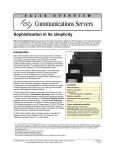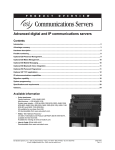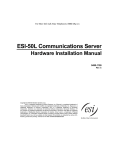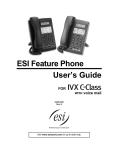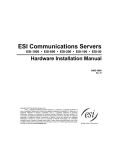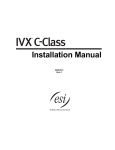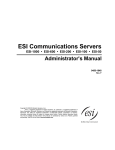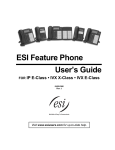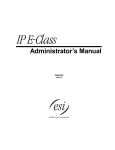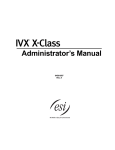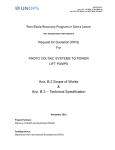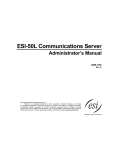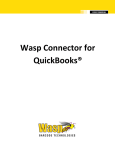Download ESI 24-Key Digital Feature Phone Specifications
Transcript
Advanced digital and IP communications servers ESI Communications Servers represent an innovative approach to digital and IP communications. The science behind the switch is sophisticated in its simplicity: Design a platform with the flexibility to support digital functionality with the ability to be configured as a purely IP-based communications system. It’s ideal for any business that wants the familiarity of digital telephony, the benefits of full IP-to-the-desktop, or anything in-between. Introduction ESI Communications Servers come in several models, to handle everything from the modest call-handling needs of a small business to the large, customized needs of the enterprise. Each ESI Communications Server is fully flexible. That means it can support traditional digital stations, IP-based, or any combination thereof that 1 the customer requires. The largest model, the ESI-1000, supports a maximum system capacity of 1,128 communications ports. 2 An ESI Communications Server’s backplane , switching matrix, and main board are designed to allow for a traditional digital installation or a VoIP configuration in varying capacities. The non-blocking architecture increases station capacity to a full complement of up to 3 816 telephones. ESI Communications Servers share many common functions and features. Their innovative architecture integrates advanced IP functionalities, such as dedicated IP resources, the ability to support multiple Integrated VoIP Cards (IVCs), up to 96 Esi-Link channels, and remotely installed IP Feature Phones. All ESI Feature Phone models, both digital and IP-based, provide advanced ESI features. ESI Cordless Handsets come in two sizes, each of which has three models to provide more connection choices — Digital, Local IP, and Remote IP. The 48-Key IP Feature Phone II supports Power over Ethernet (PoE). The optional VIP Softphone combines the functionality of a 48-Key IP Feature Phone II and the 4 VIP Professional product in one PC-based phone. All ESI IP Phones are standards-compliant and operate with the customer’s local area network to promote Quality of Service (QoS). The 48-Key and 24-Key Feature Phones are available with backlit displays. An ESI Communications Server provides an ideal, cost-effective 5 upgrade path for several models of ESI’s IVX systems. See “Migration capability,” page 12, for more details. 1 2 3 4 5 Contents Advantage summary ........................................ 2 Hardware description ....................................... 3 Features at a glance ......................................... 4 IP telecommunications capabilities ................ 8 Migration capability ........................................ 12 System programming .................................... 12 Specifications and requirements .................. 13 Glossary ........................................................... 16 Color collaterals available Family brochure: ESI # 0450-1052. System spec sheets: ESI #s 0450-1055 (ESI-1000); 0450-1056 (ESI-600); 0450-1054 (ESI-200); 0450-1053 (ESI-100); 0450-1148 (ESI-50); and 0450-1149 (ESI-50L). All downloadable from www.esi-estech.com/brochures. All ESI documents mentioned herein are available from www.esiresellers.com (password required). To support certain ESI Communications Server features — most notably automatic call distribution (ACD) and any IP-related features — the entry-level ESI-50L must be upgraded to an ESI-50. As a result, a number of descriptions in this document do not apply to the ESI-50L. For a complete comparison of ESI systems’ features, consult the Technical and Features Comparison Chart (ESI # 0450-0447), downloadable from www.esiresellers.com/tech (password required). Except on the ESI-100, ESI-50, or ESI-50L. See “Capacity constraints,” page 9. See the VIP Product Overview (ESI # 0450-0608). IVX E-Class (IVX 128e and IVX 72e) Generation II and IVX X-Class (IVX 128x and 256x). ESI (Estech Systems, Inc.) • 3701 E. Plano Parkway • Plano, TX 75074 • 800 374-0422 • fax: 972 422-9705 e-mail: [email protected] • Web: www.esi-estech.com 0450-1076 Rev. D ESI Communications Servers Product Overview Advantage summary Standard features Note: Maximum capacities shown. Capacities System Caller ID key • Distinctive ring for trunks ESI50L • Enhanced Caller ID 1,128 624 300 108 87 48 • Esi-Dex integrated directories Trunk ports 240 168 84 42 35 16 DLCs (for T1/PRI) 10 6 3 1 1 0 • Fax tone detection Flexible numbering plans 1 2 34 17 8 3 1 0 • 816 408 192 84 52 40 IP stations Digital stations 816 504 408 336 192 168 72 48 12 32 0 32 • Recording of calls • Shared-office tenanting (maximum of eight tenants) Analog stations 384 188 56 28 8 8 • Station redial and callback 4 2 1 1 1 2 0 64 64 24 16 16 16 ESI1000 ESI600 ESI200 ESI100 ESI50 ESI50L 128 32 16 or 24 8 6 6 1,941 1,481 1,229 1,121 258 246 816 408 192 84 52 40 Info./guest 1,000 1,000 1,000 1,000 190 190 Group/ Max. members 64/200 32/64 16/48 16/32 16/32 16/32 On-board integrated auto-attendant/ voice mail chs. Total voice mailboxes User “Specialpurpose” Voice storage 6 (hrs.) 61 1,200 41 21 1,200 140 or 600 21 21 21 140 15 or 60 15 7 Optional applications Voice mail 6 • ESI50 Esi-Link cards (up to 24 Esi-Link 4 chs./card) Conference 5 ports 5 Built-in Network Services Processor (NSP) ESI100 3 4 • 7 ESI200 Station ports 3 Automatic call distribution ESI600 IVCs 2 Account codes • ESI1000 System ports 1 • The ESI-50 doesn’t support T1. The ESI-50 has a built-in IVC; it accepts no additional IVCs. The built-in IVC supports 12 local IP channels, eight remote IP channels, or a combination thereof whose total can’t exceed 12 IP channels. See “Capacity constraints,” page 9. Esi-Link channels are allocated to “reserved” ports; i.e., Esi-Link channels don’t reduce CO or station capacity. Dynamic assignment allows for unlimited combinations up to the maximum of 16 parties per conference — e.g., 21 three-member conferences, or four four-member conferences in combination with two eight-member conferences. Achieves best audio performance when using digital trunks. The differing quantities for the ESI-200 and ESI-50 reflect those models’ Memory Module choices. • ESI Presence Management • ESI Bluetooth Voice Integration • Mirrored Memory Module (M3) • Esi-Link IP private networking • Power over Ethernet support for IP Feature Phone II • Dual-configuration 48-key IP Feature Phone II (supports local and remote installations) • Digital, Local IP , and Remote IP Cordless Handsets • Third-party SIP stations • VIP (Visually Integrated Phone) and VIP Professional • VIP ACD Supervisor and VIP ACD Agent • VIP PC Attendant Console • VIP Softphone • ESI Personal Programmer 7 8 9 2 8 7 7 7 7 7 9 7 7 7 7 Not applicable to the ESI-50L. Standard on the ESI-1000; not available on the ESI-100, ESI-50, or ESI-50L. See “IP telecommunications capabilities,” page 8. ESI Communications Servers Product Overview Each cabinet has a grounding lug and solder terminal for the connection of a ground wire. It is highly recommended that all cabinets be grounded to a common grounding point by “pig-tailing” the ground wire from one cabinet to the one below it. Hardware description System configurations ESI-1000, ESI-600, ESI-200 Cabinet connection The largest-capacity ESI Communications Servers — the ESI-1000, ESI-600, and ESI-200 — are compact, rack-mounted systems. The maximum configuration of each consists of one Base Cabinet and the following number of Expansion Cabinets (maximums shown): Expansion Cabinets ESI-1000 5 ESI-600 3 ESI-1000, ESI-600, ESI-200 Connection between cabinets on these models is made through a SCSI (Small Computer System Interface) cable, which is shipped with each Expansion Cabinet. This SCSI cable extends the motherboard from cabinet to cabinet, creating a common backplane. ESI-200 1 The ESI-200’s Expansion Cabinet is unique to that model, while the ESI-1000 and ESI-600 share the same Expansion Cabinet. If desired, the cabinets may be wall-mounted, but rack-mounting is the preferred method of installation. ESI-100, ESI-50, ESI-50L Connection between cabinets on these models is made through a ribbon cable that connects between port cards in adjoining “piggybacked” cabinets. ESI-100, ESI-50, ESI-50L Main board The ESI-100, ESI-50, and ESI-50L each consists of a compact Base Cabinet with the same form factor of ESI’s long-popular IVX products. Each accepts one Expansion Cabinet through a “piggyback” method. Typically, these systems’ cabinets are wall-mounted. The Main Board houses a built-in Network Services Processor (NSP) for all applications requiring direct connection of the ESI Communications Server to the customer’s local area network. These applications include SMDR, system programming via TCP/IP, and ESI options such as the VIP family of software 1 applications . Processing Processing power is provided by a Motorola® ColdFire® commercial-grade microprocessor, designed specifically for 24/7 operation. This device houses SDRAM for stored program control. It also interfaces with 3 on-board DSPs that manage the HDD controller, inter-card communications, and telephony services, ensuring rapid, dependable communications among all system resources: trunks, digital stations, and IP Phones. The ColdFire processor’s model, speed, and SDRAM capacity vary by ESI Communications Server model: Processor model ESI1000 MCF5407 ESI600 MCF5407 ESI200 MCF5407 ESI100 MCF5272 ESI50 MCF5272 2 The M3 (Mirrored Memory Module) provides a full, real-time back-up of system programming data and voice messages. The M3 is designed with RAID 1 redundancy technology. If the main hard disk drive controller senses a drive failure, it will automatically switch to the mirrored drive and continue to run. This switch of drives initiates an audible alarm with a visual LED indication on the front panel of the Base Cabinet. Fully flexible platform Each ESI Communications Server offers impressive expansion capabilities. On each model other than the ESI-50 and ESI-50L, each available card slot accepts either digital or IP cards, to allow the customer maximum flexibility in configuration. The ESI-50 comes with one built-in IVC (which is its maximum capacity for IVCs); and the ESI-50 and ESI-50L each have the capabilities of a 482 port card (see “Port cards supported,” page 14) on the main board. ESI50L MCF5272 Speed (MHz) 54 54 54 66 66 66 SDRAM (MB) 128 128 64 32 32 32 Power provisions For each ESI Communications Server’s capacities, 3 refer to “Advantage summary,” page 2. Each cabinet is powered by its own power supply. In rack-mounted installations, a power shelf is available that provides AC connection for each of the cabinet power supplies. This reduces the number of AC power outlets needed to one, instead of one per power supply. When a UPS system is installed, only one connection to the UPS must be made from the system, rather than one from each of the cabinets. The power shelf is separately fused to protect system components against erratic power fluctuations. 1 2 3 3 The ESI-50L doesn’t support VIP ACD Supervisor, VIP ACD Agent, or VIP Softphone. Standard on the ESI-1000; optional on the ESI-600 and ESI-200; not available for the ESI-100, ESI-50, or ESI-50L. See also “Capacity constraints,” page 9. ESI Communications Servers Product Overview Features at a glance Note: For system-by-system details on quantities for features described in this section, see the “Advantage summary” on page 2. An ESI Communications Server combines the power of a PBX with the ease of use for which every ESI phone system is renowned. Its feature set, capacities and scalability ensure: Availability of all features , functionalities and tools ESI offers to increase the productivity of an enterprise. • Expansion ability to meet shifting demands of business growth. Integrated voice mail — A full complement of practical, easy-to-use voice mail features is standard on every ESI Communications Server: • In addition to its call processing ports, an ESI Communications Server is configured with built-in voice mail channels. There is no need to balance voice mail needs at the expense of a customer’s call-handling requirements. • Voice mail and other message storage are recorded at the highest grade of voice quality (64-Kbit/ second sampling). • Substantial voice message storage ensures ample capacity for all mailbox users, including the needs of users enabled with the optional auto-record feature. • Leaving messages for up to 65 mailboxes at once is ™ easy, using ESI’s unique Quick Groups feature. • ESI’s Quick Move function enables conversations to be recorded directly into another user’s mailbox. At the mailbox user’s option, urgent messages can be treated with priority and delivered first, instead of on a “first in-first out” basis. • Several different mailbox types — including group, broadcast, information, cascade paging, Q & A, and guest mailboxes — support a wide range of customer applications. • Callers forwarded to user or guest voice mailboxes can reach the called individual at a designated off-premises “reach me” number. • 100 branches (six levels deep) to permit the design of a more natural, caller-friendly answering environment, including a company directory. • Virtually unlimited call routing, including off-premises transfer. • Three-character dial-by-name for callers to search through the auto attendant directory and all Esi-Dex directories to find the desired name. 3 – Nine customizable recordings. • One or more stations may have a programmable ™ Virtual Mailbox Key on their stations to allow easy monitoring of a second mailbox. Shared-office tenanting — Businesses can share a common telephone system while maintaining a true separation of various system resources, facilities, and features: – Three pre-recorded tracks. New-message notification can be delivered offpremises to a phone or pager. • Flexible conference channels — Each ESI Communications Server reserves channels for 2 conferencing. These can be dynamically connected in multi-party conversations up to 16 channels per conference. Any combination of conference channels may be joined together, as long as the originating party is an ESI Communications Server user. All channels reserved for conferencing are dynamically balanced for optimum audio performance. Support for 12 message-on-hold recordings: • Each user mailbox is equipped with a Message Recycle Bin that remembers, and can restore, the 10 most recently deleted messages. Auto attendant — An ESI Communications Server provides rich, comprehensive auto attendant features: 1 • • ™ • Private or dedicated outside lines by line groups. • Distinctive incoming ring assignments per tenant. • Separate auto attendant greetings and branches. • Individual “dial 0” operators, music-on-hold sources, and paging zones. • Unique day/night modes of operation. 2 1 See the Technical and Features Comparison Chart (ESI # 0450-0447) for specific feature availability and capacities for all ESI Communications Servers. 3 4 Dynamic assignment of the conference channels allows for any combination of members (up to the maximum of 16) per conference — e.g., on the ESI-1000 or ESI-600, ten four-member conferences and three eight-member conferences can take place simultaneously. Not supported by the ESI-50L. ESI Communications Servers Product Overview 1 Intelligent Call Forwarding™ — Users of an ESI Communications Server equipped with one or more 1 PRI digital trunk circuits have access to this unique feature. Users who forward their calls off-premises are able to view the original Caller ID data of incoming 4 forwarded calls. Enhanced automatic call distribution — Manage call overload and increase customer satisfaction with 2 ESI’s standard call center feature. ACD ensures that: • Calls are prioritized and routed within designated departments for quickest possible call handling. • Managers and agents receive up-to-the-second information on queues and wait times via any 48-Key or 24-Key Feature Phone display. • Supervisors have access to agents’ ACD call activity to more effectively evaluate call traffic and agent performance. • A separate hold recall timer is provided for ACD agents, further ensuring that customer care is enhanced. • Agents may log into two separate ACD departments simultaneously, with departmental prioritization. 5 Personal Caller ID — For situations in which the company’s leading number identification data may not be the appropriate Caller ID for individual station users, an ESI Communications Server makes it possible to define a different Caller ID number to be associated with, and sent for, each individual user. This feature 6 provides E-911 support. Flexible numbering Flexible numbering provides the means to assign extensions, mailboxes, and department numbers based on specific customer requirements. An ESI Communications Server’s flexible numbering is separated into three parts: Verbal User Guide™ — Users have instant access to assistance in operating their ESI phones and voice 3 mailboxes. By pressing the HELP key, the user is presented with extensive spoken and displayed prompts to assist with phone operation, voice mail features, programming instructions, and more. System Administrators and Reseller technicians can also use the Verbal User Guide to prompt them through infrequently used programming changes. 1. Selecting a numbering plan template; 2. Reassigning ranges of extensions, speed-dial numbers, and guest mailboxes (if needed); 3. Reassigning numbers for individual extensions, speed-dial numbers, guest mailboxes, and departments. Esi-Dex™ — Locating and calling hundreds of frequently dialed phone numbers is easy when using ESI’s Esi-Dex speed-dialing feature. Up to four separate lists (“Dexes”) are available: Selectable numbering plans • Station Dex — All extensions within the system. • Personal Dex — All speed-dial entries programmed by each individual user. • System Dex — All speed-dial entries stored system-wide. The selectable numbering plan template is the basis for flexible numbering assignment. When a numbering template is selected, all extensions, mailboxes, departments, and other system features are automatically assigned with the numbering plan of that template. Choosing the template that is closest to the customer’s existing configuration greatly simplifies, or even eliminates the need for, number reassignment. • Location Dex (available when Esi-Link is installed) — Lists all dial access codes associated with each location within an Esi-Link private network. The quantity (four or three) of digits in extension numbers determines the number of stations that can be connected to the ESI Communications Server: Saving numbers to the Personal Dex is just as easy. When Caller ID is presented with an incoming call or a voice mail message, one touch of the ESI-DEX key stores the provided number for future use. 1 2 3 Plan chosen Four-digit Three-digit 4 Not supported by the ESI-50L. The optional VIP ACD application allows even easier and more substantial management of ACD operations. See the VIP ACD Product Overview (ESI # 0450-0988). Not available from an ESI Cordless Handset. 5 6 5 ESI1000 816 168 Extension numbers available ESIESIESIESI600 200 100 50 408 192 84 52 168 168 84 52 ESI50L n/a 40 For more details about this feature, see the Intelligent Call Forwarding Feature Overview (ESI # 0450-0674). Requires the installation of a PRI digital trunk circuit (and thus is not available on the ESI-50L). Check local regulations regarding E-911 compliance. ESI Communications Servers Product Overview Range reassignment Optional ESI Presence Management Flexible number range assignment is used to change the numbers of a block, or range, of extensions, speeddial numbers, guest mailboxes, or departments. ESI Presence Management — RFID scanning technology combines with an ESI Communications Server to offer an innovation in presence status, call control, entrance security, and documented tracking of users’ work hours and attendance history. Highlighted benefits of ESI Presence Management include: The flexible numbering plan is very useful in matching station extension numbers with blocks of DID numbers assigned by the telephone company. If a customer already has an extension number directory assigned and does not want to change it, the flexible dialing plan will also accommodate this request. Number reassignment The number reassignment function will let the Installer assign new — or reassign existing — numbers for individual extensions, speed-dial numbers, departments, and mailboxes. Station move Station move is used by the Installer or System Administrator to move, or exchange, extension numbers and other station information between 1 extensions of the same station type. Programmable feature keys, personal greetings, voice mail messages, and other station information are automatically and instantly exchanged between the two stations when station move is done. Remote entry control with built-in doorphone. Access control through the use of authorized electronic keys (key fobs or scan cards). Presence indication to show “in” and “out” status of employees on programmed DSS keys. Personal Call Routing to modify the behavior of a station when the user is scanned in or out. Optional third-party software to track, sort, and prepare employees’ attendance data for easy entry into common business payroll software applications. For more complete details about ESI Presence Management, consult the ESI Presence Management Product Overview (ESI # 0450-0794). Optional ESI Bluetooth Voice Integration The Installer can use a separate programming function for flexible reassignment of station and department numbers through ESI System Programmer. Optional ESI Bluetooth Voice Integration products allow businesses to simplify and enhance communications, using Bluetooth-enabled cell phones and headsets with ESI Communications Servers. Available products include ESI Cellular Management and the ESI Bluetooth Headset Integration. Esi-Link and selectable numbering In an Esi-Link network, certain ESI Communications Server selectable numbering templates can be incompatible with some ESI systems. For additional details about these compatibility issues, refer to the Esi-Link Product Overview (ESI # 0450-0214). ESI Cellular Management is a Bluetooth access device which interfaces directly with an ESI Communications Server and lets busy professionals make and receive cell phone calls on their ESI 48-Key 3 Feature Phone. Available numbering plan templates To view the available numbering plan templates, refer to the Flexible Numbering Feature Overview (ESI # 0450-0952). When a cell phone is connected via Bluetooth in range of the access device, the cell phone’s calls are routed to the destination programmed at installation: any 48Key Feature Phone extension, department, or mailbox. The inbound cellular call is then managed by the ESI Communications Server just like any other CO trunk call and may access standard ESI features, such as call forwarding, transferring, conferencing, call recording, department call coverage, and routing to mailboxes. 2 1 2 Such stations must be like types — e.g., Digital Feature Phone to Digital Feature Phone, IP Feature Phone to IP Feature Phone, or analog extension to analog extension. 3 6 WaspTime software is not sold by ESI but, rather, is available for direct purchase from the manufacturer, Wasp Barcode Technologies (www.waspbarcode.com). Digital or IP. ESI Communications Servers Product Overview ESI Cellular Management users can: • Select whether unanswered calls to their cell phone are routed to their ESI voice mailbox or their cellular voice mail. • Decide whether to have their cell phone connect to the access device automatically or manually when desired, depending on their needs. • Choose to share access to their cell phone (and minutes in their cellular calling plan) with others in their office. On any ESI phone, one may program a DSS key which, when pressed, accesses the connected cell phone for outbound calls. • Access their cellular provider’s voice dialing feature (if applicable), using a key on their ESI 48-Key Feature Phone. • Use the voice transfer feature to disconnect a cell phone from the access device during the conversation and continue the call using the cell phone. Optional VIP PC applications ESI’s optional VIP takes the power of Microsoft® Outlook® and adds a missing critical application: control of phone calls, faxes, and voice mail messages. VIP is offered in several configurations: the basic VIP, VIP Professional, VIP PC Attendant Console, VIP ACD 5 Supervisor, VIP ACD Agent, and VIP Softphone. VIP PC Attendant Console, VIP ACD Supervisor, and VIP Softphone are sold in single-seat licenses. VIP Professional and VIP ACD Agent licenses can be combined to add seats in quantities of two, five, 25, 100, and unlimited. The basic VIP is sold separately in seats of two, five, 25, 100, and unlimited. The maximum number of seats for VIP PC Attendant Console and VIP ACD Supervisor on an ESI Communications Server varies by model: The ESI Bluetooth Headset Interface is an add-on device which integrates directly with an ESI 48-Key 1 Feature Phone , allowing users to “pair” a standard 2 Bluetooth headset. Once connected in this fashion, the headset user may answer, originate, and terminate calls seamlessly, using the key on the Bluetooth headset. The ESI Bluetooth Headset Interface maintains all headset capabilities available on ESI Communications Servers, but frees users from traditional and costly wired headsets and handset lifters. Installations 4 ESI50 2 ESI50L 2 All VIP users can: Best of all, ESI Personal Programmer requires no license. It is available for download at no charge from the ESI User’s Guide Web site (www.esiusers.com), and the Installation Wizard makes setup a snap. 3 ESI100 2 Each ESI Communications Server supports integration with third-party fax server applications in systems equipped with a digital PRI circuit. Each VIP user receives his faxes in that user’s own Outlook Inbox as an attachment. Faxes can be printed, archived, or attached to any e-mail for forwarding. This improves office efficiency, and ensures that sensitive faxed information is not lying in a common fax machine’s tray. With ESI System Programmer, users can program their 3 station’s greetings, password, DSS keys, presence , 4 off-premises “reach-me,” and cell phone management settings directly from the program. Administrators, too, can use it to modify any phone on the system. 2 ESI200 4 The familiar Windows® graphical user interface is intuitive and easy to learn, requiring minimal training. With VIP, the user handles incoming and outgoing calls, manages contacts, and organizes voice mail and faxes, all through the Outlook Inbox. Voice mail messages or personal recordings may be saved as .WAV files. Station programming is easy with ESI Personal Programmer. This application can be used by individual users and System Administrators to perform station programming on ESI Communications Servers. 1 ESI600 8 The maximum number of VIP Softphone licenses is dependent upon the available IP channels provided with an installed IVC. Optional ESI Personal Programmer Note: ESI1000 16 ESI Personal Programmer is compatible with Windows XP and Windows Vista. It is mutually exclusive with VIP. Digital or IP. Bluetooth headsets sold separately (not available from ESI). Requires optional ESI Presence Management. Requires optional ESI Cellular Management (an ESI Bluetooth Voice Integration product). • Manage voice mail, e-mail and faxes from the Outlook Inbox. • Organize all contacts in one convenient list. • Control the ESI Feature Phone from a desktop PC. • Capture all inbound and outgoing calls in historical log files. • Program the phone with just a few mouse-clicks. • Manage optional ESI Bluetooth Voice Integration (if applicable for their ESI installation). 5 7 The ESI-50L lacks support for ACD and IP-related features and, therefore, doesn’t support VIP ACD Supervisor, VIP ACD Agent, or VIP Softphone. ESI Communications Servers Product Overview Users of VIP Professional, VIP PC Attendant Console, VIP ACD Supervisor, VIP ACD Agent, and VIP Softphone receive additional benefits: • VIP Product Overview (ESI # 0450-0608; contains details concerning basic VIP, VIP Professional, and VIP Softphone) • An enhanced graphical user interface (GUI) to further increase user efficiency. • VIP PC Attendant Console Product Overview (ESI # 0450-0914) • Text-messaging to provide a quick method of communication between users of these applications. • VIP ACD Supervisor/ACD Agent Product Overview (ESI # 0450-0988) • An auto-record feature, so select users (up to 16) never again miss recording important calls. The quantity of auto-recording installations varies by ESI Communications Server model: ESI-1000 ESI-600 32 16 Installations ESI-200 8 IP telecommunications capabilities ESI-100 4 Note: Information concerning IP-related capabilities isn’t applicable for the ESI-50L. To support IP telecommunications, the ESI-50 must be upgraded to an ESI-50. VIP PC Attendant Console provides superior call handling abilities for busy attendants: • Incoming Calls and Holding Calls displays that show calls in the attendant queue, calls that were re-routed to the operator, and system-wide recalling held calls. • A 400-button Virtual Button Window for singleclick access to stations, departments, speed-dial numbers, and mailboxes, as well as many of the system features which can be assigned to programmable feature keys. The ESI Communications Server architecture provides 5 a robust infrastructure for both LAN -based IP telephony and remote IP applications. 1 Standards-based design ESI Communications Servers’ IP capabilities are supported by compliance with major industry standards. ESI employs all applicable standards to ensure that, regardless of location, ESI Communications Server IP users experience the best audio quality. VIP ACD Supervisor’s benefits include: • A real-time status display of departmental performance, including service level. • A view of agent status — logged in, logged out, 2 wrap, DND, off-hook, and off-premises. • Access to six departmental reports. • User Datagram Protocol (UDP). • Layer 3 QoS support via DiffServ (Differentiated Services). • Voice compression methods of G.711 (for locally installed IP stations), G.726 (for remotely installed IP stations and VIP Softphone), and G.729 (for Esi-Link connectivity). 3 VIP ACD Agent gives each ACD agent: • A view of agent status — DND, off-hook, 2 and off-premises. • Log-on, log-off, and wrap control for up to two departments, directly from the PC. Note: The ESI-50 uses only the G.726 speech compression algorithm and, therefore, can be in an Esi-Link network with only other ESI Communications Servers set to G.726. ESI’s ® IVX X-Class and IVX E-Class systems, as well as the original ESI-600 (prior to system software version 16.2.0) use only the G.729 speech compression algorithm; thus, an ESI-50 cannot be in an Esi-Link network with these systems. 4 The VIP Softphone user benefits from: • Combined operation of VIP Professional-level features and an IP Phone resident within the PC. • Local or remote operation. Unlike many unified messaging offerings, VIP does not require installation of a Microsoft Exchange® server. This puts a powerful call and message management tool within financial reach for even smaller businesses. For more details, consult the following documents: 1 2 3 4 200-button on the ESI-200, ESI-100, ESI-50, and ESI-50L. Off-premises indication requires optional ESI Presence Management (see the ESI Presence Management Product Overview, ESI #0450-0794). Requires the third-party Crystal Reports application. VIP Softphone requires use of a USB headset. • 802.3 100Base-TX Ethernet interfaces. • Layer 2 Quality of Service (QoS) support through compliance with 802.1p for voice packet prioritization and 802.1q for VLAN (Layer 2) support. • 802.3af Power over Ethernet. • Dynamic Host Configuration Protocol (DHCP) for IP address conservation within a customer’s LAN. • Session Initiated Protocol (SIP) to support local SIP-compliant third-party IP telephones. 5 8 Local area network. ESI Communications Servers Product Overview Capacity constraints IP station sets An ESI Communications Server’s full station capacity can be reached either (a.) with all extensions installed as IP stations or (b.) when a minimum number of the installed stations are IP instruments (as shown in the following table). An ESI Communications Server supports several types of IP telephones: Config. for full capacity Card slots used IVCs Digital/analog cards Minimum IP stations Other stations ESI1000 42 of 42 29 ESI600 26 of 28 14 ESI200 13 of 14 6 ESI100 4 of 4 3 13 12 7 1 696 336 144 72 12 120 72 48 12 40 • ESI50 5 1 of 5 2 1 3 plus 1 built-in The phone includes built-in Power over Ethernet (PoE) capabilities for those customers whose LAN employs powered switches. In cases where the customer does not have PoE switches installed, the optional 48VDC adapter is used to provide operating power to the phone. The IVC supports ESI’s Power Over Ethernet (PoE) IP Phones installed locally or remotely, in any combination. If any IVC fails, only the IP stations assigned to that card will go off-line. When connected to an ESI Communications Server, the 48-Key IP Feature Phone II can optionally utilize DHCP to obtain an IP address from the customer’s LAN. If the customer’s LAN does not support DHCP, a static IP address will automatically be assigned by the system. Esi-Link private IP networking capabilities The Esi-Link IVC is reserved for the support of either eight or 24 Esi-Link channels. With the Esi-Link IP networking option, up to 100 individual sites may be 2 connected together via a customer’s WAN or the Internet. The 48-Key IP Feature Phone II may also be installed outside the confines of the customer’s LAN. When installed remotely, the phone uses the higher compression rate of G.726 to maximize voice quality. A remote location might include a remote facility, home office, or any other location where broadband Internet access is available. Remote IP users are connected directly to the system, and operate as if they were on-premises. The following table shows how many Esi-Link IVCs may be installed in each ESI Communications Server, and the resulting number of possible, simultaneous VoIP connections between systems: Maximums Esi-Link IVCs Inter-system VoIP conns. ESI1000 ESI600 ESI200 ESI100 ESI50 4 2 1 1 1 96 48 24 24 8 3 For further details, see the Esi-Link Product Overview (ESI document #0450-0214). ESI-trained Resellers may download this document from www.esiresellers.com/docs (password required). 1 2 3 The 48-Key IP Feature Phone II (available with backlit display) can be installed in-house on the customer’s network, or remotely wherever a broadband connection to the Internet is available. There is a two-port Ethernet switch built into the IP Feature Phone II. This provides a single Ethernet connection to the network for both the customer’s IP Phone and his office computer. Support for Quality of Service (see “Quality of Service (QoS) support,” page 10) is critical in this type of installation, to ensure that there is no loss of audio or dropped voice packets during large data downloads. One 482 card and one IVC are built into the ESI-50. Wide area network. This single built-in IVC supports both local and remote IP channels. With the maximum of eight Esi-Link channels in use, only four local channels are available for use. The ESI Local IP Cordless Handset provides connection of the customer’s LAN to the phone’s base station. Users of Local IP Cordless Handsets are free to move throughout their facility while staying in touch with customers and co-workers. • For remote teleworkers, ESI also offers the 4 Remote IP Cordless Handset. This phone connects like a “wired” Remote IP Phone, and can be installed anywhere broadband Internet access is available. The teleworker’s home phone line can be connected into the Remote IP Cordless Handset’s base station. • The optional VIP Softphone combines the functionality of a 48-Key IP Feature Phone II and the VIP Professional product in one PC-based phone. For more information about this product, see also “Optional VIP PC applications,” beginning on page 7, as well as the VIP Product Overview (ESI # 0450-0608). 4 9 4 • See the ESI Cordless Handsets Product Overview (ESI # 0450-0840). ESI Communications Servers Product Overview • ESI additionally supports SIP-compliant hardware endpoints — i.e., SIP “phones.” However, due to limitations with SIP itself, not all of the ESI feature set is available via a SIP phone. The following SIP hardware endpoints have been tested with ESI Communications Servers: • Unlike data packets, voice packets cannot be resent 1 if they are dropped. Jitter is reduced for voice packets by QoS. This improves the likelihood that all voice packets will not be dropped before being delivered at the other end of the IP conversation, as happens when the amount of jitter of a packet exceeds an acceptable level. • The latency with which voice packets are delivered is minimized in a network employing QoS. This results in more natural-sounding speech patterns for both sides of an IP conversation. – Aastra 9133i – Grandstream BudgeTone 101 – Grandstream HandyTone 286 Note: Each compatible ESI IP Phone [IP Feature Phone II, IP Cordless Handset (Local or Remote), or VIP Softphone] or SIP endpoint requires an available IVC port and the activation in the system of either a local or remote license before the IVC will connect to the IP Phone. When an IP Phone is programmed in the system, a license is consumed. 802.1p and 802.1q standards for VLANs Virtual LANs (VLANs) provide a method of separating data streams to make a local area network appear to be two or more networks. A VLAN is likely to be implemented in a business where IP telephony is heavily used. The VLAN segregates the voice packets onto their own network to prevent the degradation of voice quality, loss of packets, and late delivery of voice packets (latency). Quality of Service (QoS) support Quality of Service is an important component in any converged or pure IP telephone system. It increases the likelihood for IP voice communications to be clear, and free of dropped calls and delayed audio. Two standards are concerned with VLAN. Both are required to be supported in order to adequately support VLAN operation. These are: QoS is defined as providing the means for specific data streams in a network to be prioritized over other types of traffic. In the case of a voice over IP application, the IP packets carrying the voice conversation are given priority over data packets. When using the built-in two-port data switch to connect the IP Phone and customer’s computer to the same Ethernet port, it is highly advisable for the customer’s network to support QoS so that large downloads do not affect the quality of voice communications to the IP Phone. • 802.1p — Provides for the prioritization of voice packets. This standard establishes eight levels of priority, 0 through 7, with 7 being the highest priority. Level 7 is reserved for those applications and packets that are considered network-critical. Levels 5 and 6 identify packets that are delay-sensitive. Priority levels below 5 are used for “loss-eligible” data, meaning that if a packet is lost and must be retransmitted, nothing is affected. This is not the case with voice, where if a packet is lost, portions of words will be missing or unintelligible. ESI defines its prioritization field at 5. Benefits of QoS • Networks that are designed to support QoS are best suited for IP deployment since quality of voice is judged by the end-to-end experience of the user. It is not sufficient for ESI’s IP applications to support QoS if all network components used in the transport of voice over the customer’s LAN are not properly configured for QoS support. 802.1q — Dictates how the prioritization level (or “tag”) is attached to each packet. Without this tagging of voice packets, prioritization would not be possible because there would be no differentiation between types of packets. By compliance to the 802.1p and 802.1q standards, ESI’s local IP Phones have built-in prioritization to simplify managing traffic and QoS over a LAN. The benefits of end-to-end QoS in any IP telephony application are many, and when absent, quite noticeable to the user: • Available bandwidth is optimized by ensuring that voice packets are sent and delivered at a higher priority than “regular” data traffic on the LAN. This may allow the customer to delay upgrading the speed of transmission of his network. He may be able to defer this expense until other applications are added or IT changes in the business dictate it is necessary. • The quality of the IP conversation is improved by ensuring that voice packets are delivered and “reassembled” at the other end of the conversation in order. This eliminates garbled conversation, hollowness, and noticeable gaps in speech. 1 10 The variation from packet-to-packet in transit time, expressed in milliseconds. For a more detailed explanation, see the Esi-Link Product Overview (ESI # 0450-0214). ESI Communications Servers Product Overview Differentiated Services (DiffServ) Power over Ethernet (PoE) This standard is primarily used with remote IP Phones and Esi-Link installations in a WAN environment. This protocol allows IP voice packets to be prioritized over data transmission in LAN/WAN environments whose routers provide prioritization. As with all QoS provisioning within a LAN or WAN, the network components, such as routers and switches, must be able to support, and be configured for Quality of Service. ESI’s 48-Key IP Feature Phone II complies with the IEEE 802.3af standard for powering devices over a customer’s existing local area network. This enhancement requires the customer to install the appropriate PoE network components, such as switches and routers. The 48-Key IP Feature Phone II can also be powered by using the optional 48VDC adapter. There are many benefits to designing an IP telephony application with Power over Ethernet capabilities: Some Internet connections may not support DiffServ. Contact the customer’s ISP to determine whether it supports DiffServ. • By using the local area network to power the IP Phones, a consistent voltage is provided to all phones without the fluctuations that frequently occur in commercial office buildings. • Since all power is provided from one location, a single UPS system can be used to protect the IP Phones from power surges, brown-outs, and other electrical anomalies. • Powering the IP Phones via the customer’s LAN saves the cost and inconvenience of providing a fused power strip at each IP Phone placement. Dedicated voice over IP resources A codec is used to take the analog spoken voice, encode it as an IP packet so it can be compressed and transmitted as a “data” packet. When received by another IP device (IP Phone or other Esi-Link system), the IP packet is decoded so that it is converted back into analog voice. Communication via IP is not possible without codecs. Three types of industry-standard codecs are used by ESI’s 48-Key IP Feature Phone II and IVCs: G.711, G.726, and G.729. This refers to the amount of compression that a voice packet will undergo when being converted into an IP packet. ESI has tested several Power over Ethernet devices for compatibility with its PoE IP Phones: G.711 is the non-compressed standard from which all other compression standards are established. IP Phones 1 that are locally installed use G.711. Each 48-Key IP Feature Phone II has built-in G.711 and G.726 codecs. Additionally, each channel of the IVC has dedicated G.711 and G.726 codecs for conversion between unlike compression standards. This conversion ability of the IVC allows intelligible audio between remotelyinstalled and locally-installed IP Phones. Cisco Catalyst 3560 24-port 10/100T PoE • Adtran Netvanta 1224 PoE • 3Com Superstack 3 4400 switch power • 3Com PW130 In addition, the following mid-span Power over Ethernet devices have been tested: Calls to or from a remotely-installed IP Phone use standard compression rates of G.726 (calls to/from the IVC) and G.729 (calls to/from Esi-Link channels). This reduces latency in the IP conversation and minimizes dropped or lost packets. Each of the 24 channels on the IVC has a dedicated G.726 codec to support the connection of remotely installed IP Phones. The Esi-Link IVC is equipped with 24 dedicated G.729 codecs. By dedicating codecs on each available IVC and Esi-Link IVC channel, an IP Phone or Esi-Link user will never be denied the ability to place or receive a call due to the lack of a codec. Notes: The ESI-50 uses only the G.726 speech compression algorithm and, therefore, can be in an Esi-Link network with only other ESI Communications Servers set to G.726. ESI’s ® IVX X-Class and IVX E-Class systems, as well as the original ESI-600 (prior to system software version 16.2.0) use only the G.729 speech compression algorithm; thus, an ESI-50 cannot be in an Esi-Link network with these systems. 1 • Local and remote installations of VIP Softphone use G.726. 11 • 3Com 3CNJPSE24 24-port Midspan Solution • D-link DWL-P1012 12-port PoE Midspan ESI Communications Servers Product Overview Migration capability System programming For customers who outgrow their existing ESI systems, an ESI Communications Server provides the perfect 1 2 upgrade path. Most ESI station equipment currently installed on a legacy IVX E-Class or X-Class system may be reinstalled on an ESI Communications Server: Programming the ESI Communications Server family is greatly simplified through use of ESI System Programmer. Designed from the ground up, using the latest in object-oriented programming technology, this tool provides Installers and System Administrators the ability to easily review and modify the programming on any ESI Communications Server. ESI station equipment 48-Key Digital Feature Phone 48-Key IP Feature Phone II 24-Key Digital Feature Phone 12-Key Digital Feature Phone ESI Digital Cordless Handset ESI Local IP Cordless Handset ESI Remote IP Cordless Handset 60-Key Expansion Console 60-Key Second Expansion Console VIP Softphone (software installation) 48-Key [local] IP Feature Phone 48-Key Remote IP Feature Phone 16-Key Digital Feature Phone 16-Key [local] IP Feature Phone 16-Key Remote IP Feature Phone Supported? Yes 3 Yes Yes Yes Yes 3 Yes 3 Yes Yes Yes 3 Yes No No No No No ESI System Programmer is built on highly reliable industry protocols to enhance communication between the phone system and the programming application. Installers and System Administrators can navigate through an easy-to-use “tree” menu to access programming functions. The intuitive graphical user interface (GUI) makes learning the tool as simple as it is to use, resulting in a shortened training time for new technicians and System Administrators. This application’s dependable backup-and-restore functionality retains programming, recorded custom prompts, and Caller ID information — giving you peace-of-mind when unforeseen circumstances occur. The following are built into ESI System Programmer: Each ESI Communications Server supports a wide range of port cards; however, pre-“Generation II” legacy cards (see the table below) cannot be used on this platform, because they lack the processing power and memory storage required for proper operation in a large system with a heavier traffic load: Cards NOT supported by ESI Communications Servers Port card 612 684 D12 A12 LNC DLC12 IVC Part no. 5000-0104 5000-0160 5000-0135 5000-0160 5000-0149 5000-0157 5000-0318 No migration path is available for customers of the legacy IVX Series (IVX 128, IVX 20, and their “Plus” versions), the original IVX, IP E-Class (IP 200e and IP 40e), and IP Series (IP 200 and IP 40) systems. Migrating from an ESI-50L to a 60-hour ESI-50 requires a different CompactFlash Memory Module, because the ESI-50L’s Memory Module is a 15-hour model. 2 3 Programming of all phone system functions • Send/Receive of programming • Rapid programming using templates • Robust error-checking to prevent common mistakes • Instant feedback informs whether data was successfully sent, and provides warnings and alerts about potential problems • Built-in help to guide the Installer or System Administrator as required • Import of system software Included with ESI System Programmer are three additional applications — Esi-Address, Esi-Check, and Esi-Networx — to assist with programming and debugging. Generally, all “Generation II” (“E2”) port cards are fully supported by the ESI-1000, ESI-600, ESI-200, and ESI-100. 1 • Note that the ESI-50 and ESI-50L support the 482 port card, and the ESI-50 supports the DLC82. These cards are compatible with no other ESI Communications Server. IP equipment requires installation of IVC — except on the ESI-50, which has a built-in IVC. The ESI-50L doesn’t support IP communications. Not supported by the ESI-50L. 12 ESI Communications Servers Product Overview Specifications and requirements • On the ESI-1000, ESI-600, and ESI-200 — Each cabinet has its own power supply unit to support the inserted port cards. Cabinets are connected together through front-mounted cables. • On the ESI-100, ESI-50, and ESI-50L — Each system uses one power supply to support both the Base Cabinet and the single available Expansion Cabinet. Each requires a “piggyback” method to mount the Expansion Cabinet onto the Base Cabinet. Capacities Note: Refer also to “Capacities” in the “Advantage Summary” (page 2). Because they accept both digital and IP stations, and due to the more flexible configurations this capability allows, ESI Communications Servers possess station capacities far beyond those of most legacy ESI platforms. At the top of the list is the ESI-1000, which supports up 1 to 816 stations when configured appropriately. The Base Cabinet holds the main board, which controls all call control and switching within the ESI Communications Server. The main board also contains these integrated connectors and components: Each IVC supports 24 channels, to which local IP Phones or remotely installed IP Phones may be connected. This is double the station capacity of any port card that supports digital phones. Therefore, the maximum station capacity can be achieved with 1 maximum use of IVCs and IP stations. The next table depicts maximum trunk capacities among the ESI Communications Servers. A certain quantity of trunks in each model may be digital (T1 2 and/or PRI ), connected to the system via one or more 3 ESI digital line cards (DLCs). Maximums Trunks Digital (T1/PRI) DLCs ESI1000 240 ESI600 168 ESI200 84 ESI100 42 ESI50 35 ESI50L 16 240 144 72 24 23 — 10 6 3 1 1 — • Memory Module — A hard drive with improved performance that contains all system programming and configuration data, and pre-loaded voice prompts. Each Memory Module provides voice storage at 64 kilobits/second — the industry's highest-quality sampling rate. • Network Services Processor (NSP) — The NSP consists of a dedicated Motorola® ColdFire® processor and Ethernet port. The front-panel RJ-45 jack provides a 10/100Base-T connection to a site’s 5 LAN. In its basic configuration, the NSP provides remote access via Ethernet and the Internet for system programming and maintenance. The NSP is required for all LAN-based options, such as the various VIP applications. On the ESI-50, the NSP further allows programming of the built-in IVC. • M3 memory back-up — Using RAID -1 hard drive technology, the Mirrored Memory Module (M3) maintains system operation on a separate disk drive in the event of a hard drive failure. M3 is required when redundancy of system programming, speeddial entries, and voice mail messages and prompts is desired. The M3 drive and interface constitute a standard feature on the ESI-1000, and are optional on the ESI-600 and ESI-200. • On-board MOH and overhead paging inputs — Connection of ancillary equipment is easy using the system’s built-in jacks. • Serial port — SMDR call detail data is output from this port. Technicians connect their laptop computers to this port to perform on-site programming. The table below shows how many Esi-Link channels may be configured in each ESI Communications Server. This maximum is achieved by installing up to the limit of Esi-Link IVCs in the system. Esi-Link channels do not detract from the number of available 4 station or trunk ports. Maximums ESI-1000 Esi-Link chs. 96 Esi-Link IVCs 4 ESI-600 48 2 ESI-200 24 1 ESI-100 24 1 System components Each ESI Communications Server is comprised of one Base Cabinet, with the capability of adding one to five Expansion Cabinets, depending on model (for details, see “Hardware description,” page 3). 1 2 3 4 6 Also on the main board for the ESI-50 and ESI-50L are a built-in 482 card; and the ESI-50 main board additionally has a built-in IVC. See “Capacity constraints,” page 9. PRI only on the ESI-50. The ESI-50L doesn’t support T1 or PRI. See “Port cards supported,” page 14. Except on the ESI-50 and its built-in IVC — on which, the more Esi-Link channels (up to eight) are in use, the fewer local IP channels are available. No more than 12 total IP channels may be in use. 5 6 13 Local area network. RAID means Redundant Array of Independent Drives. ESI Communications Servers Product Overview Port cards supported ESI Communications Servers support a wide range of port cards. Any E2 port card can be used on the ESI-1000, ESI-600, and ESI-200 with the use of an additional E2 Port Card “Hot Swap” Adapter (as for the ESI-100, see “Hot-swap operations,” below the following table). The CS port cards (not for use with the ESI-100, ESI-50, or ESI-50L) are full-size cards with built-in “hot-swap” capability, along with a special “ejector-handle” mechanism that makes them literally a snap to install or uninstall. The following port cards are supported: Ports Port card CS-684 CS-612 CS-6ALC CS-A12 CS-D12 CS-DLC12 CS-DLC CS-IVC 24R CS-IVC 24EL CS-IVC 12R12EL E2-684 E2-612 ESI-6ALC E2-A12 E2-D12 E2-DLC12 ESI-DLC 2 IVC 24R IVC 24EL IVC 12R12EL DLC82 482 COs 6 6 6 System maximums (port cards) Esi-Link 1 Analog Stations stations channels 8 digital 12 digital ESI1000 ESI600 ESI200 24 42 42 42 32 42 10 10 34 4 28 28 28 15 28 6 6 17 2 14 14 14 4 14 3 3 8 1 12 4 2 1 24 12 42 42 42 32 42 10 10 34 4 4 28 28 28 15 28 6 6 17 2 2 14 14 14 4 14 3 3 8 1 1 4 12 12 digital 24 (T1) or 23B +1D (PRI) 12 digital 24 (T1) or 23B +1D (PRI) 24 IP 12 IP 6 6 6 8 digital 12 digital 4 12 12 digital 24 (T1) or 23B +1D (PRI) 12 digital 24 (T1) or 23B +1D (PRI) 24 IP 23B +1D (PRI) 4 IVC 12 12 IP 8 digital 8 digital 12 IP (local or rem. chs.) 2 2 ESI100 ESI50 ESI50L 1 3 4 4 1 1 3 4 — 4 4 4 2 4 1 1 3 1 1 12 Note: The ESI-50’s built-in IVC 12 can support up to 12 local IP stations or up to 8 remote IP channels. It can use local IP, remote IP, and Es-Link channels in various combinations, which are activated in blocks of four for local IP, singles for remote IP, and blocks of four for Esi-Link. However, the combinations cannot exceed a total of 12 stations/channels. Hot-swap operations “CS” port cards — full-sized cards for use on only the ESI-1000, ESI-600, and ESI-200 — have built-in hot-swap capability, allowing you to replace them while the system is powered-up. To achieve hot-swap capability with an “E2” port card requires mounting it onto a “Hot-Swap” Port Card Adapter prior to installation on the ESI-1000, ESI-600, or ESI-200. However, installing a new port card requires power-cycling the system to allow it to recognize the new card. Note: For a more complete description of the port cards, and additional details concerning hot-swap operations on compatible ESI Communications Servers, consult the ESI Communications Servers Hardware Installation Manual (ESI # 0450-1049). 1 2 3 4 For each IVC, the quantity of IP stations is a combination of locally and remotely installed IP phones. Previously called IVCR24. One of the four 482 cards is built-in (ESI-50 and ESI-50L only). Built into the main board (ESI-50 and ESI-50L only). 14 ESI Communications Servers Product Overview Power consumption Environmental considerations The following table shows the power consumption of each ESI Communications Server when fully loaded: When planning the installation of an ESI Communications Server, observe good common sense by providing a dry, clean and accessible area. System ESI-1000 ESI-600 ESI-200 ESI-100 ESI-50 ESI-50L Cabinets (Base and Expansion) 6 4 2 2 2 2 Power consumption (watts) 1,080 720 360 125 72 72 If the equipment is to be rack-mounted, ensure that there is adequate room for a standard 19˝ rack. If wallmounting is planned, ensure that all power cords have ready availability to a 110 VAC power outlet. For optimum performance, ensure that the system is located no further than 1,000 feet from the farthest station location. An ESI Communications Server is tolerant of broad ranges in environmental characteristics: ESI-1000, ESI-600, and ESI-200 For the ESI-1000, ESI-600, or ESI-200, each Base Cabinet or Expansion Cabinet is powered by its own separately fused power transformer. For rack-mounted systems, a power shelf is available onto which all power transformers may be mounted so only one power cable is required for connection to a commercial AC power outlet or UPS system. • Ambient room temperature should fall within the range of 40°–80° F. • Relative humidity in the room should not exceed 90%. FCC regulatory information Each ESI Communications Server model has been tested and found to comply with the limits for a Class A digital device, pursuant to Part 15 and Part 68 of the FCC Rules. These limits are designed to provide reasonable protection against harmful interference when the system is operated in a commercial environment. Since each cabinet has its own distributed power, the heat dissipation of each power “brick” is well within the environmental range for proper operation of all system components. In an installation environment with insufficient space surrounding the system and mounting rack, the power shelf may be mounted at the top of the rack (above the Base Cabinet) so that the power bricks can utilize convection cooling as a means of dissipating any potential build-up of heat. ESI Communications Servers and all associated ESI telephone station equipment meet all FCC requirements for hearing-aid compatibility. NTS Test Report B5317 includes all testing procedures and satisfactory results data. The FCC number for all ESI Communications Servers is 1T1MF08B33727, with a ringer equivalency of 0.8. ESI-100, ESI-50, and ESI-50L For the ESI-100, ESI-50, and ESI-50L, each Base Cabinet shares a 24-VAC power supply “brick” (fiveamp on the ESI-100, and three-amp on the ESI-50 and ESI-50L) with an Expansion Cabinet which is installed upon the Base Cabinet. Typically, the connected cabinets will be wall-mounted, which should provide sufficient space to allow venting of heat from the power supply. 15 ESI Communications Servers Product Overview Glossary Codec — The device required to encode analog spoken voice into IP packets for transmission through a VoIP network. The encoded voice is decoded at the receiving end, converting voice into an analog component. HDD — Hard Disk Drive; the device on which the system’s operating software program, and voice mail prompts and messages are stored. IEEE — Institute of Electrical Engineers; the professional organization that establishes standards for, among others, the telecommunications industry. ICC — Inter-card communication; describes the method by which cards within a cabinet, as well as multiple card cabinets, communicate with each other. NSP — Network Services Processor; the ESI device, mounted on the Main Board, that provides for an Ethernet connection between the ESI Communications Server and the customer’s local area network (LAN). Multiple applications may run concurrently over the NSP connection, such as VIP and remote Internet programming. PoE — Power over Ethernet; this IEEE standard (802.3af) defines the method of injecting power over a customer’s local area network cabling infrastructure to operate TCP/IP devices at the Ethernet port. ESI uses this method, in conjunction with a customer-provided power switch, to operate its PoE local IP Phones. RF — Radio frequency. RFID — Radio frequency identification. RAID1 — Redundant array of independent drives. VoIP — Voice over Internet Protocol. About ESI ESI (Estech Systems, Inc.) is a privately held corporation based in Plano, Texas. Founded in 1987, ESI specializes in business communications systems. ESI pioneered the all-in-one telephone and voice mail system. The original IVX, introduced in 1996, represented a radical breakthrough in system design: the inclusion of a full suite of features within a single integrated system. Since its days as a small start-up, ESI has enjoyed exceptional stability and growth while maintaining its dedication to small-company values — including the need to take care of the most important part of the equation: your business. Copyright © 2009 ESI (Estech Systems, Inc.). IVX is a registered trademark of ESI. Other registered trade names mentioned herein are trademarks of their respective owners. ESI phone systems are protected by various U.S. Patents, granted and pending. Product appearance, and other details and features described herein, are subject to change without notice. Some features may not be available at initial release. More information on ESI and its products is available on the World Wide Web at www.esi-estech.com. 16
















